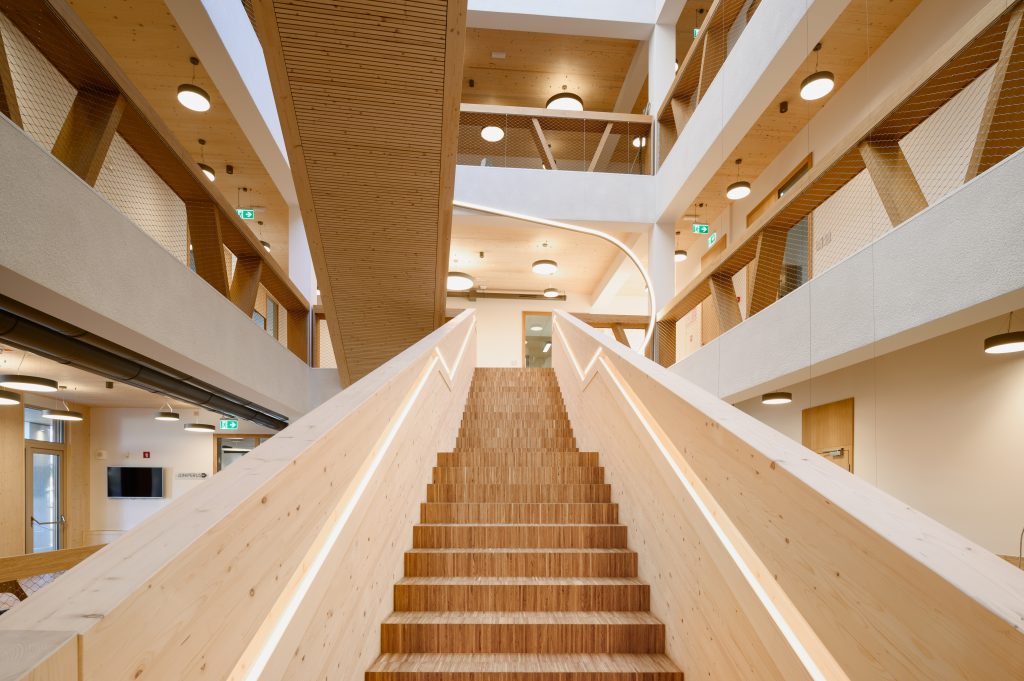
January 7, 2026

A modern working environment is now more than ever connected to sitting and screens. The hours people spend sitting at a table is reflected in our body. Today, it is probably rare not to get the typical problems that such a posture causes – from a tight neck and painful wrists to bumps between the shoulder blades and low back pain. Problems associated with long-term sitting or professionally sedentary behaviour, which is defined as any sitting, lying or reclining position while in the workplace where energy expenditure is very low, never seem to end.
Consequences that sedentary work could cause
• Musculo-skeletal: Low back pain, neck pain, shoulder ring and wrist pain. Discomfort and pain could be the result of a prolonged and relatively static posture, especially when slouch sitting. This may result in a disproportion between the muscle groups; for example, during sitting, hip flexors are in a shortened position while hip extensors are in extended position. Similar disproportions may also be present in other muscle groups.• Cardiovascular: Development of non-communicable chronic diseases, such as high blood pressure, type 2 diabetes, abdominal obesity and high cholesterol. Recent research on this is not encouraging, as it has been shown that long-term sedentariness is an independent risk factor for non-communicable diseases, which means that physical activity mitigates the consequences but does not prevent them.• Feeling down: Mood can be affected by a slouching posture. When slouching, breathing becomes shallower, which reduces the oxygen supply to the body, thus decreasing the supply of oxygen to the brain. Feeling tired, drowsy or apathetic may be alleviated by checking the posture and taking a deep breath.• Eye disorders: Tired and dry eyes. This could be caused by constant focus on a short distance. |
“The key problem is that both employees and their employers are not aware enough of the consequences that sedentary behaviour brings,” says Nastja Podrekar, research assistant at the InnoRenew CoE.
Podrekar is involved in the research project “Ergonomic, adjustable and active office furniture”, which seeks to find tangible solutions and raise awareness about this issue.
How to plan an office and working rhythm?
How should the active office be organized? Since its main purpose is to encourage employees “not to stiffen”, it is organized to enable the exchange between seated and standing positions. Some of this can be achieved by having a telephone conversation when standing or by walking to the printer and garbage basket farthest away from the workplace. However, these moving activities during work are not enough. It is recommended that, if possible, every hour workers stand up for a short time, stretch and make a step or two.
“It is important to remember that short-term interruptions of the sitting position have many positive effects”, stresses Podrekar.
Active breaks are also recommended. This means that up to three times a shift, workers should take a few minutes to exercise, stretch, relieve and strengthen (more detailed instructions are presented at the end of the article).
Another upgrade for the active office is appropriate furniture. In addition to adjustable chairs, adjustable tables are becoming more available. These tables are classified into four versions. In the first (basic), the table is fixed and the chair is adjustable. In the second, the table is adjustable, depending on body dimensions (in this case, first the chair is set, then the table). The third option includes a sit-to-stand table, which means working while sitting or standing is possible. The fourth version is a standing table with chair of corresponding height that does not require changes in the table settings (i.e., a simpler movement for adjusting the height between sitting and getting up). Newer elements of ergonomically designed furniture, which are not suitable for every office, are bike desks and treadmill desks. Bike desks are an “office” bike – a special office chair with corresponding higher table which enables the worker to cycle while working. Treadmill desks, on the other hand, enable workers to walk while working.
Testing and measurements
In the project “Ergonomic, adjustable and active office furniture”, project partners at the University of Primorska (mainly Faculty of Health Sciences), the InnoRenew CoE, Slovenian National Building and Civil Engineering Institute, Slovenia’s National Institute for Public Health, the Regional Development Agency of the Ljubljana Urban Region and Zavod e-Oblak have already produced an ergonomically shaped, adjustable, sit-to-stand table that enables both sitting and standing work in the pilot stage.
The innovation of this table, as mentioned by Podrekar, is a built-in control system into which the height for seated and standing position can be entered with the time interval for changing from one position to another. Table height changes according to the entered data. If changes to the obtained position are not wanted, the activity can simply be cancelled.
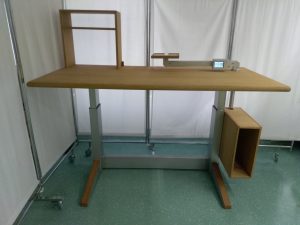
Adjustable sit-to-stand table, with built-in control system, which allows automatic change to the desired height. Photo: Nastja Podrekar
In addition, a chair for laboratory testing was designed for optimizing ergonomics. The test chair allows subjects to change height, depth and inclination of the seat as well as height and inclination of the backrest. The adjustable frame can accommodate differently designed seat pans and backrests. By changing chair properties, the project partners would like to find optimal ratios and parameters in a sitting position in which the spine is as neutral as possible, thus achieving preventive effects.
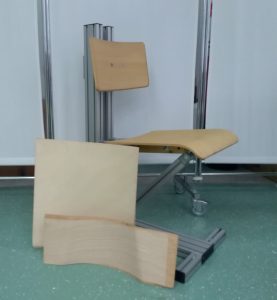
Adjustable chair and additional seat / backrest. Photo: Nastja Podrekar
To determine this, a special pressure mapping system is placed on the seat and backrest. This system reads the body’s pressure distribution on the chair. The peak of pressure is usually in the area of the sitting bones. Since excess pressure of individual body parts on the chair do not work well on the body as a whole, the goal is that pressure of all the parts is evenly distributed.
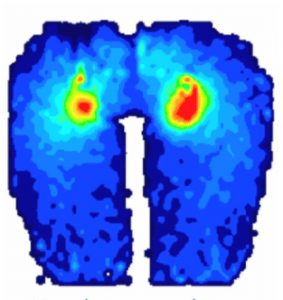
Display of body pressure distribution while sitting, captured by a pressure mapping system. Photo: Nastja Podrekar
Additionally, project partners will perform a kinematic analysis of posture. In these tests, sensors are placed on key anatomical parts (neck, shoulders, lower back, head, knee and hip). With cameras that detect sensors, relationships or angles between body parts in different types of seating can be monitored. This way, project partners can find out how different shapes and furniture settings (chair, table, screen heights) affect deviations from the neutral posture of the body, which is fundamental in prevention. Results of these measurements will contribute to the improved ergonomical design of the chair.
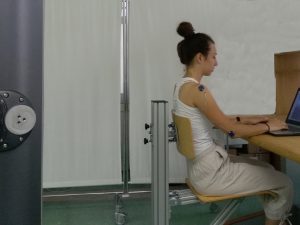
Symbolic presentation of kinematic analysis of the position of the shoulder and elbow (on the left is the camera that detects sensors). Photo: Nastja Podrekar
In addition to designing and testing the most appropriate furniture, evaluation of worker’s sedentary behaviour and physical activity is also of great interest to the project. One method for obtaining information about sitting and physical activity is questionnaires. However, it has been shown that participants often indicate a smaller number of hours spent sitting (about two hours a day) than is shown by more objective measurements. Objective measurements are carried out with special accelerometers, currently the most internationally advanced motion sensors. Two types of sensors are used in the tests. The first type is placed on the thigh for at least seven days in order to evaluate time spent in a sitting or lying position, movement, sleep and the number of steps. The second type recognizes intensity of the movement activity and is positioned around the waist.
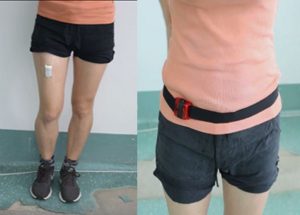
Accelerometer ActivPAL (left picture) for evaluation of sedentary behaviour and ActiGraph (right picture) for evaluation of the intensity of movement activity. Photo: Nastja Podrekar
On the field
“Issues related to sedentary behaviour and workplace ergonomics generally do not get enough attention in Slovenia, which is why this topic is not incorporated too much in public administration, where we would expect more enthusiasm,” says Podrekar.
Given the number of employees and the nature of their work, public administration is a large area of the working environment, which would require ‘’tailored’’ approaches. Therefore, cooperation with the Slovenian Police Union (Sindikat policistov Slovenije), as agreed upon by the project, is even more valuable. Testing police officers based on questionnaires and sensors is already under way. At the moment, the data obtained is being analysed, and, according to the results, the project leaders and police union will work together on possible solutions for improvements.
The project’s designers anticipate that their findings will be useful more broadly, both in terms of awareness-raising and improvements in existing workplaces as well as in the design and manufacture of furniture, i.e. in the industry. Additionally, Podrekar finds it particularly important to take this issue more seriously in school environments and to provide school furniture that would be more appropriate than what currently exists; all in all problems start here. The good news is that talks in this direction are already under way.
It’s not all about the furniture, however, says Podrekar.
“The key to everything is ergonomic furniture and an informed user of this furniture – just the furniture itself does not solve all the problems, of course,” she notes.
Hopefully, this will encourage workers to think about a more diverse working day and make the first step with expert recommendations for interrupting sitting work.
Tips for exercise during office hours
· Get up every hour for 10-20 seconds and stretch; take a step or two.· Interrupt the view focused on the screen (short distance) and look in the far distance as many times as possible.· Cover the eyes with the palms for 10 seconds so that the fullest possible darkness is achieved and eyes don’t close.· One to three times per shift take 3-5 minutes for exercise. The following exercises are recommended: |
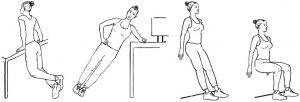
Relaxing and strengthening exercises. Illustration: Nastja Podrekar

Stretching exercises. Illustration: Nastja Podrekar